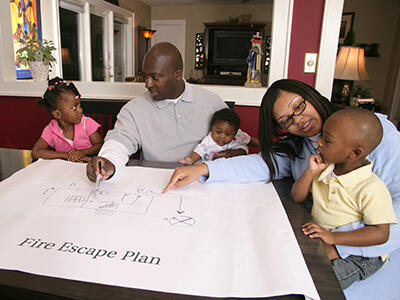When the smoke alarm sounds, you may have as little as 3 minutes to escape. Make and practice your home escape plan with the whole family so you'll know what to do in an emergency.
Why you need a home escape plan
- Working smoke alarms and a home fire escape plan can reduce your risk of injury or death in a fire.
- Most fatal fires happen in homes.
- When fire strikes you may have less than one minute to get out of the building.
- Fires double in size every minute.
- Fires create thick, black, choking smoke which makes it impossible to see or breathe.
- Fires produce heat, smoke and toxic gases.
Additional Resources
-
Open PDF file, 254.56 KB, Home Escape Planning (English) (English, PDF 254.56 KB)
-
Open PDF file, 245.29 KB, Home Escape Planning (Spanish) (English, PDF 245.29 KB)
-
Open MP4 file, 66.51 MB, Home Escape planning video lesson (English, MP4 66.51 MB)
Make a home escape plan
- Plan a home escape route that includes two ways out of every room. Draw a floor plan of your home. Include all doors, windows, halls, stairs and fire escapes that can be used to get outside. Use arrows to show the escape route and the two ways out of each room.
- Choose a meeting place outdoors.
- Make sure that each family member can open door locks and window latches.
- Check to see if all windows that are part of the escape plan open easily and have not been painted shut.
- If your home has security bars or child window guards, they should have a quick-release feature that can be operated from the inside.
- Keep pathways through the house clear of obstacles such as furniture, newspapers, toys, etc.
- Plan around your abilities. If you wear eyeglasses or hearing aids, keep them at your bedside along with a flashlight.
- Post your house numbers on the outside of the home. Make sure the number is clearly visible from the street.
Practice your home escape plan
Home escape plans work only if you practice them! Teach your home escape route and meeting place to everyone in the home.
- Have fire drills frequently, at least twice a year, so actions become automatic behaviors.
- Hold one family fire drill during the day when everyone is awake and a second drill at night when children are asleep to see how they will respond.
- After a drill, make necessary adjustments to your plan.
- Does someone in the household who is young or physically impaired need assistance? An adult can go to their room and help that person to escape.
- If a child sleeps through the alarm an adult has to wake them.
- Carry infants and toddlers to safety.
What to do when an alarm sounds
- Roll out of bed to the floor and stay low beneath the smoke. Crawl to the door.
- Check the door for heat with the back of your hand. If the door feels cool, open it slowly. If the coast is clear of fire, crawl to escape.
- Do not open a hot door. Place a towel or blanket at the base of the door to keep smoke out. Crawl to a window and open it. Turn on a light. If you can safely reach the ground, exit. Otherwise, shout and signal for help. Don’t jump. A firefighter’s first priority is to rescue people.
- Signal others by calling or banging on walls.
- Leave the building.
- Get out and stay out!
- Go to the family meeting place.
- Dial 911 from a neighbor’s house.
- Wait at the meeting place for the fire department to arrive. Let them know if everyone is safe.
